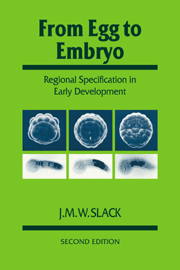Book contents
- Frontmatter
- Contents
- Preface to the second edition
- Preface to the first edition
- 1 Regional specification in animal development
- 2 The concepts of experimental embryology
- 3 Theoretical embryology
- 4 Hierarchies of developmental decisions
- 5 Development with a small cell number
- 6 Models for Man: the mouse and the chick
- 7 The breakthrough
- 8 What does it all mean?
- Appendix: How to write a program for development
- References
- Index
6 - Models for Man: the mouse and the chick
Published online by Cambridge University Press: 16 October 2009
- Frontmatter
- Contents
- Preface to the second edition
- Preface to the first edition
- 1 Regional specification in animal development
- 2 The concepts of experimental embryology
- 3 Theoretical embryology
- 4 Hierarchies of developmental decisions
- 5 Development with a small cell number
- 6 Models for Man: the mouse and the chick
- 7 The breakthrough
- 8 What does it all mean?
- Appendix: How to write a program for development
- References
- Index
Summary
THE MOUSE
Although rabbits were used to some extent in the early days and rats are still used for certain purposes, the mouse has become the mainline organism for mammalian experimental embryology. This has led to the terms ‘mouse’ and ‘mammal’ being used almost interchangeably, but it should be remembered that the morphology of early development can differ considerably in other mammals, not least in the human. Unlike the other creatures considered in this book, mammals are viviparous and the resulting inaccessibility of the postimplantation stages of development causes severe problems for the embryologist. For the early, preimplantation, stages the embryos are located first in the oviduct and then the uterus of the mother. During this time mouse embryos can be collected and kept in vitro in reasonably simple media and most experiments have involved manipulation of these early stages. Where later development is essential to the result the preimplantation embryos are transplanted into the uteri of ‘foster mothers’ who have been made ‘pseudopregnant’, and thus receptive to the embryos, by previous mating with sterile males.
Since the in vivo manipulation of postimplantation stages is very difficult, and their culture in vitro is still only feasible for periods less than 3 days, most mouse embryology is really ‘pre-embryology’ dealing not with the formation of the embryo body plan but of various extraembryonic membranes which are segregated during the pre- and peri-implantation phase and which are necessary to the support and nutrition of the embryo proper.
- Type
- Chapter
- Information
- From Egg to EmbryoRegional Specification in Early Development, pp. 171 - 212Publisher: Cambridge University PressPrint publication year: 1991

